— Updates 2020 Outlook for Acquisition of Decision Resources Group —
London, UK and Philadelphia, US — February 27, 2020 – Clarivate Analytics Plc (NYSE: CCC, CCC.WS) (the “Company” or “Clarivate”), a global leader in providing trusted insights and analytics to accelerate the pace of innovation, today reported results for the fourth quarter and full year ended December 31, 2019.
Financial Highlights
- Fourth quarter 2019 revenues of $255.0 million increased 4% on a reported basis and up 4.2% at constant currency* for the quarter
- Fourth quarter 2019 net loss of $84.8 million compared to a net loss of $43.5 million in the prior year quarter; adjusted net income* of $41.9 million increased 31.3% for the quarter
- Fourth quarter 2019 adjusted EBITDA* of $84.6 million increased 11.6% for the quarter
- Net cash from operating activities increased to $117.6 million in 2019 compared to a use of cash of $26.1 million in the prior year
- Free cash flow* increased $119.3 million to $47.8 million in 2019 compared to a use of cash of $71.5 million in the prior year
“Clarivate had an outstanding year in 2019, achieving numerous strategic and financial initiatives, which positions us for continued growth,” said Jerre Stead, Executive Chairman and CEO of Clarivate. “We closed out 2019 with strong financial performance in the fourth quarter with total revenue growth of 4% including subscription revenue growth of 6% and Annual Contract Value of subscription-based agreements increasing 3.5%. We also delivered double-digit adjusted EBITDA growth of more than 11%. Our positive momentum is continuing in 2020 with the acquisition of Decision Resources Group, which, when consummated, will more than double the size of our life sciences business and sets us up to be the leading data and analytics provider in that industry.”
Selected Financial Information

* Non-GAAP measure. Please see “Reconciliation to Certain Non-GAAP measures” in this earnings release for important disclosures and reconciliations of these financial measures to the most directly comparable GAAP measure. These terms are defined elsewhere in this earnings release.
Fourth Quarter 2019 Operating Results
Revenues, net, for the fourth quarter of 2019 increased $9.8 million, or 4%, to $255.0 million, compared to the prior-year period.
Subscription revenues for the fourth quarter of 2019 increased $11.9 million, or 6%, to $209.5 million, compared to the prior-year period, primarily due to price increases and new business within both the Science Product Group and IP Product Group.
Transactional revenues for the fourth quarter of 2019 decreased $2.2 million, or 4.6%, to $45.6 million, compared to the prior-year period, primarily due to a decrease in backfile sales, lower CompuMarkTM search volumes and IP services offset by an increase from the Techstreet products.
Net loss for the fourth quarter of 2019 was $84.8 million, or ($0.28) per share, compared to a net loss of $43.5 million, or $(0.20) per share, in the prior-year period. The decline in the fourth quarter of 2019 is primarily due to the impact of debt refinancing charges, restructuring charges and an impairment on assets held for sale resulting from the MarkMonitor asset divestitures.
Adjusted EBITDA for the fourth quarter of 2019 increased by 11.6% to $84.6 million, compared to the prior-year period, driven by higher revenues and ongoing cost savings initiatives.
Adjusted net income for the fourth quarter of 2019 increased 31.3% to $41.9 million, or $0.13 per diluted share, compared to $31.9 million, or $0.15 per diluted share, in the prior-year period. The fourth quarter of 2019 adjusted earnings per diluted share was lower compared to the prior-year period due to a 51% or 110.7 million increase in the weighted average common shares outstanding as a result of the merger with Churchill Capital Corp in May 2019.
Full Year Operating Results
Revenues, net, for the full year 2019 increased by $5.9 million, or 0.6%, to $974.3 million, compared to the prior year.
Adjusted Revenues for the full year 2019, which exclude the impact of the deferred revenues adjustment and revenues from the IPM Product Line divested in October 2018, increased $23.6 million, or 2.5%, to $974.8 million, compared to the prior year. On a constant currency basis, Adjusted Revenues increased $29.5 million, or 3.1%, for the full year 2019.
Subscription revenues for the full year 2019 increased 1.4% to $805.5 million, compared to the prior year. Adjusted subscription revenues for the full year 2019, which exclude the impact of the deferred revenues adjustment and revenues from the IPM Product Line as noted above, increased 3.7%, and on a constant currency basis increased 4.3%, compared to the prior year primarily due to price increases and new business within the Science Product Group and IP Product Group.
Transactional revenues for the full year 2019 decreased 4.7% to $169.3 million, compared to the prior year. Adjusted transactional revenues for the full year 2019, which exclude the impact of the deferred revenues adjustment and revenues from the IPM Product Line as noted above, decreased 3.1% on a reported basis, and decreased 2.3% on a constant currency basis, compared to the prior year, due to demand for patent services in the period, and reflected timing and product offerings within the Science and IP Product Group.
Net loss for the full year 2019 was $211.0 million, or $(0.77) per share, compared with a net loss of $242.2 million, or $(1.11), for the full year 2018.
Adjusted EBITDA for the full year 2019 increased 7.7%, to $294.0 million, compared to the prior year, driven by higher revenues and ongoing cost savings initiatives.
Adjusted net income for the full year 2019 increased 21.5% to $152.1 million, or $0.53 per diluted share, compared with adjusted net income of $125.2 million, or $0.58 per diluted share for the full year 2018. Adjusted earnings per diluted share for the full year 2019 was lower compared to 2018 primarily due to a 32% or 70.4 million increase in the weighted average common shares outstanding as a result of the merger with Churchill Capital Corp in May 2019.
Balance Sheet and Cash Flow
At December 31, 2019 cash and cash equivalents increased $50.6 million to $76.1 million, compared to December 31, 2018.
The Company’s total debt outstanding at December 31, 2019 was $1,665.0 million, a decrease of $364.0 million compared to December 31, 2018, due primarily to proceeds received from the 2019 merger with Churchill Capital Corp, which were used to reduce the Company’s outstanding debt.
Net cash provided by operating activities was $117.6 million for the twelve months ended December 31, 2019, compared to a use of cash of $26.1 million for the prior year. The increase in net cash provided by operating activities was driven principally by a lower operating loss, which included the impact of a $39.4 million gain on a legal settlement and a decrease in Transition, integration and other related expenses of $47.0 million.
Free cash flow was $47.8 million for the twelve months ended December 31, 2019, an increase of $119.3 million, compared to $(71.5) million for the prior-year period, primarily due to higher net cash provided by operating activities. Adjusted free cash flow increased to $100.5 million for the full year 2019, compared to $77.0 million for the prior-year, primarily due to higher net cash provided by operating activities, lower Transition Services Agreement costs and lower transition, integration an other related expenses.
Updated Outlook for 2020 (forward-looking statement)
For the year ending December 31, 2020, Clarivate expects:
- Adjusted Revenues in a range of $1.16 billion to $1.19 billion (previously $950 million to $970 million)
- Adjusted EBITDA in a range of $395 million to $420 million (previously $330 million to $350 million)
- Adjusted EBITDA margins in a range of 34% to 35% (previously 35% to 36%)
- Adjusted diluted EPS in a range of $0.53 to $0.59 (previously not provided)
- Adjusted Free Cash Flow in a range of $220 million to $240 million (previously $195 million to $210 million)
The updated outlook includes 10 months of financial results for the acquisition of Decision Resources Group, which the Company expects to close within the next few days.
Adjusted diluted EPS for 2020 is calculated based on approximately 381.9 million fully diluted weighted average shares outstanding, an increase of approximately 52.1 million shares or 16%, compared to 329.8 million shares outstanding at the end of December 31, 2019. The increase in shares is primarily driven by the February 2020 offering of 27.6 million shares, with proceeds used to fund a portion of the cash consideration for the acquisition of Decision Resources Group, and the issuance of approximately 24 million ordinary shares upon exercise of outstanding warrants.
The above outlook assumes no further currency movements, acquisitions, divestitures, or unanticipated events. See discussion of non-GAAP financial measures at the end of this release.
Conference Call and Webcast
Clarivate will host a conference call and webcast to review the results for the fourth quarter on Thursday, February 27th at 8:00 a.m. Eastern Time. The conference call will be simultaneously webcast on the Investor Relations section of the company’s website.
Interested parties may access the live audio broadcast by dialing 1-888-317-6003 in the United States, 1-412-317-6061 for international, and 1-866-284-3684 in Canada. The conference ID number is 3291626. An audio replay will be available approximately two hours after the completion of the call at 1-877-344-7529 in the United States, 1-412-317-0088 for international, and 1-855-669-9658 in Canada. The Replay Conference ID number is 10138014. The recording will be available for replay through March 12, 2020.
The webcast can be accessed at https://services.choruscall.com/links/ccc200227.html and will be available for replay.
Investor Day Conference on May 19, 2020
Clarivate will host an Investor Day Conference in New York City on Tuesday, May 19, 2020. Management will provide an update on the business, with presentations starting at 1:00 P.M. eastern time and concluding at 4:00 P.M. eastern time. Registration is required to attend the event. The event will be simultaneously webcast on the Investor Relations section of the company’s website. If you wish to be considered for attendance to the Investor Day Conference, please contact investor.relations@clarivate.com.
Use of Non-GAAP Financial Measures
We currently qualify as a foreign private issuer (“FPI”) under SEC rules. We will retain FPI status until at least December 31, 2020. Even though we qualify as an FPI, we report our financial results in accordance with GAAP and, beginning with our 2019 annual report, we have elected to file our periodic and current reports on Forms 10-K, 10-Q and 8-K.
Non-GAAP results are presented only as a supplement to our financial statements based on U.S. generally accepted accounting principles (“GAAP”). Non-GAAP financial information is provided to enhance the reader’s understanding of our financial performance, but none of these non-GAAP financial measures are recognized terms under GAAP and should not be considered in isolation from, or as a substitute for, financial measures calculated in accordance with GAAP.
Definitions and reconciliations of the non-GAAP measures, such as adjusted revenues, EBITDA, adjusted EBITDA and free cash flow to the most directly comparable GAAP measures are provided within the schedules attached to this release.
Forward-Looking Statements
This communication contains “forward-looking statements” as defined in the Private Securities Litigation Reform Act of 1995. These statements, which express management’s current views concerning future business, events, trends, contingencies, financial performance, or financial condition, appear at various places in this communication and may use words like “aim,” “anticipate,” “assume,” “believe,” “continue,” “could,” “estimate,” “forecast,” “future,” “goal,” “intend,” “likely,” “may,” “might,” “plan,” “potential,” “predict,” “project,” “see,” “seek,” “should,” “strategy,” “strive,” “target,” “will,” and “would” and similar expressions, and variations or negatives of these words. Examples of forward-looking statements include, among others, statements we make regarding: guidance and predictions relating to expected operating results, such as revenue growth and earnings; strategic actions such as acquisitions, joint ventures, and dispositions, the anticipated benefits therefrom, and our success in integrating acquired businesses; anticipated levels of capital expenditures in future periods; our ability to successfully realize cost savings initiatives and transition services expenses; our belief that we have sufficiently liquidity to fund our ongoing business operations; expectations of the effect on our financial condition of claims, litigation, environmental costs, contingent liabilities, and governmental and regulatory investigations and proceedings; and our strategy for customer retention, growth, product development, market position, financial results, and reserves. Forward-looking statements are neither historical facts nor assurances of future performance. Instead, they are based only on management’s current beliefs, expectations, and assumptions regarding the future of our business, future plans and strategies, projections, anticipated events and trends, the economy, and other future conditions. Because forward-looking statements relate to the future, they are difficult to predict and many of which are outside of our control. Important factors that could cause our actual results and financial condition to differ materially from those indicated in the forward-looking statements are more fully discussed under the caption “Risk Factors” in our Annual Report on Form 10-K, along with our other filings with the U.S. Securities and Exchange Commission (“SEC”). However, those factors should not be considered to be a complete statement of all potential risks and uncertainties. Additional risks and uncertainties not known to us or that we currently deem immaterial may also impair our business operations. Forward-looking statements, are based only on information currently available to our management and speaks only as of the date of this communication. We do not assume any obligation to publicly provide revisions or updates to any forward-looking statements, whether as a result of new information, future developments or otherwise, should circumstances change, except as otherwise required by securities and other applicable laws. Please consult our public filings with the SEC or on our website at www.clarivate.com.
About Clarivate Analytics
Clarivate Analytics™ is a global leader in providing trusted insights and analytics to accelerate the pace of innovation. We have built some of the most trusted brands across the innovation lifecycle, including Web of Science™, Cortellis™, Derwent™, CompuMark™, MarkMonitor™ and Techstreet™. Today, Clarivate Analytics is on a bold entrepreneurial mission to help our clients reduce the time from new ideas to life-changing innovations. For more information, please visit clarivate.com.
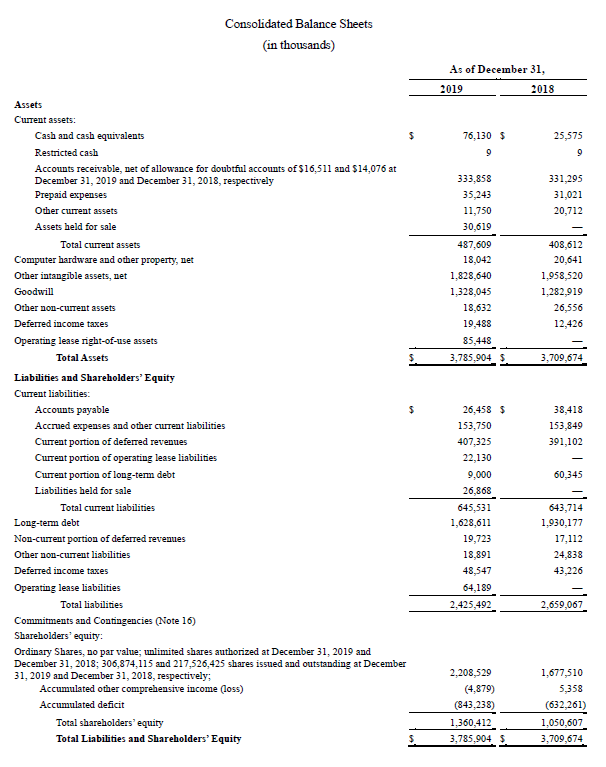
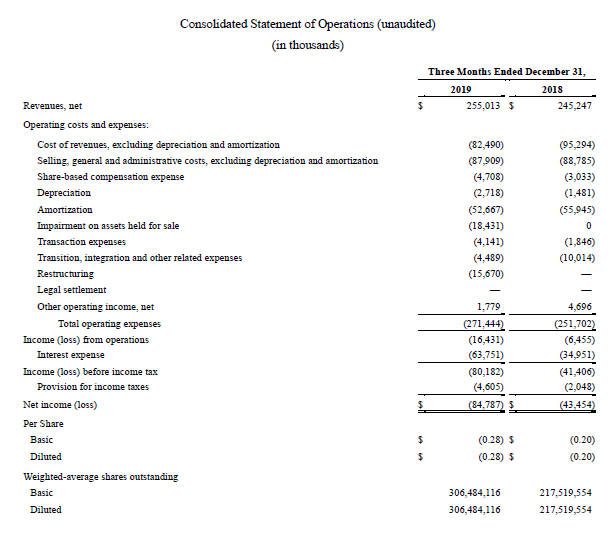


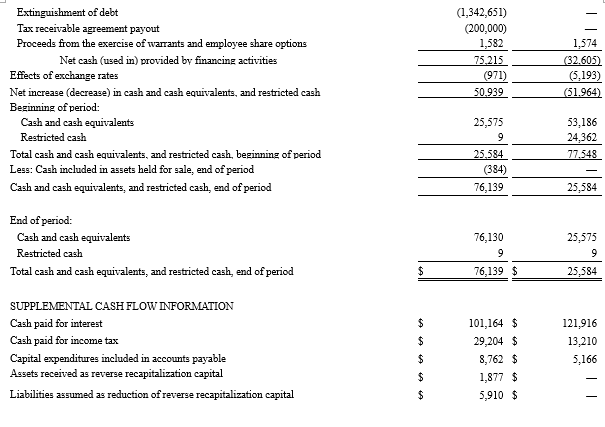
Reconciliation to Certain Non-GAAP Measures
(Amounts in tables may not sum due to rounding)
Adjusted Revenues, Adjusted Subscription Revenues and Adjusted Transactional Revenues
We present Adjusted Revenues, which excludes the impact of the deferred revenues purchase accounting adjustment (recorded in connection with the 2016 Transaction) and the revenues from the IPM Product Line prior to its divestiture. We also present Adjusted Subscription and Adjusted Transactional Revenues, which excludes the revenues from the IPM Product Line prior to its divestiture. We present these measures because we believe they are useful to readers’ understanding of the underlying trends in our operations.
Our presentation of Adjusted Revenues, Adjusted Subscription Revenues and Adjusted Transactional Revenues is presented for informational purposes only and are not necessarily indicative of our future results. You should compensate for these limitations by relying primarily on our U.S. GAAP results and only using non-GAAP measures for supplementary analysis.
The following table presents our calculation of Adjusted Revenues for the three and twelve months ended December 31, 2019 and 2018 and a reconciliation of this measure to our Revenues, net for the same periods:
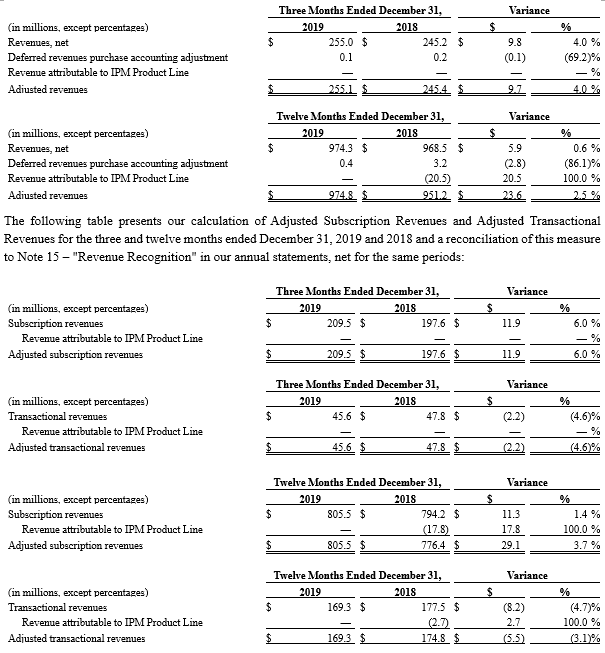
Adjusted EBITDA
We believe Adjusted EBITDA is useful to investors because similar measures are frequently used by securities analysts, investors, ratings agencies and other interested parties to evaluate our competitors and to measure the ability of companies to service their debt. Our definition of and method of calculating Adjusted EBITDA may vary from the definitions and methods used by other companies, which may limit their usefulness as comparative measures. We calculate Adjusted EBITDA by using net (loss) income before provision for income taxes, depreciation and amortization and interest income and expense adjusted to exclude acquisition or disposal-related transaction costs (such costs include net income from continuing operations before provision for income taxes, depreciation and amortization and interest income and expense from the IPM Product Line which was divested in October 2018), losses on extinguishment of debt, stock-based compensation, unrealized foreign currency gains/(losses), transition services agreement costs entered into with Thomson Reuters in 2016 (“Transition Services Agreement”), separation and integration costs, transformational and restructuring expenses, acquisition-related adjustments to deferred revenues, non-cash income/(loss) on equity and cost method investments, non-operating income or expense, the impact of certain non-cash and other items that are included in net income for the period that the Company does not consider indicative of its ongoing operating performance, and certain unusual items impacting results in a particular period.
Our presentation of Adjusted EBITDA should not be construed as an inference that our future results will be unaffected by any of the adjusted items, or that our projections and estimates will be realized in their entirety or at all. In addition, because of these limitations, Adjusted EBITDA should not be considered as a measure of liquidity or discretionary cash available to us to fund our cash needs, including investing in the growth of our business and meeting our obligations. You should compensate for these limitations by relying primarily on our U.S. GAAP results and only use Adjusted EBITDA for supplementary analysis.
The following table presents our calculation of Adjusted EBITDA for the three and twelve months ended December 31, 2019 and 2018 and reconciles these measures to our Net loss for the same periods:

- Includes accruals for payments to Thomson Reuters under the transition services agreement. These costs have decreased substantially in 2019, as we are in the final stages of implementing our standalone company infrastructure.
- Includes costs incurred in connection with and after our separation from Thomson Reuters in 2016 relating to the implementation of our standalone company infrastructure and related cost-savings initiatives. These costs include mainly transition consulting, technology infrastructure, personnel and severance expenses relating to our standalone company infrastructure, which are recorded in Transition, integration, and other line-item of our income statement, as well as expenses related to the restructuring and transformation of our business following our separation from Thomson Reuters in 2016 mainly related to the integration of separate business units into one functional organization and enhancements in our technology.
- Reflects deferred revenues fair value accounting adjustment arising from purchase price allocation in connection with our separation from Thomson Reuters in 2016 See “—Factors Affecting the Comparability of Our Results of Operations — Separation and Transition to Operations as a Standalone Business — Purchase Accounting Impact of our separation from Thomson Reuters in 2016” within the annual report.
- Includes consulting and accounting costs associated with acquisitions and the sale of the IPM Product Line and sale of MarkMonitor business
- Reflects the write down of a tax indemnity asset.
- Reflects the IPM Product Line’s operating margin, excluding amortization and depreciation, prior to its divestiture in October 2018.
- Reflects costs incurred in connection with the initiative, following our merger with Churchill Capital Corp in 2019, to streamline our operations by simplifying our organization and focusing on two product groups.
- Includes primarily the net impact of foreign exchange gains and losses related to the re-measurement of balances and other items that do not reflect our ongoing operating performance.
Adjusted Net Income and Adjusted Diluted EPS
We have begun to use Adjusted Net Income and Adjusted Diluted Earnings Per Share defined below in our analysis of the financial performance of the Company. We believe Adjusted Net Income and Adjusted Diluted EPS are meaningful measures of the performance of the Company because they adjust for items that do not directly affect our ongoing operating performance in the period. Our definition of and method of calculating Adjusted Net Income and Adjusted Diluted EPS may vary from the definitions and methods used by other companies, which may limit their usefulness as comparative measures. We calculate Adjusted Net Income by using net income (loss), adjusted to exclude acquisition or disposal-related transaction costs (such costs include net income from continuing operations before provision for income taxes, depreciation and amortization and interest income and expense from the divested business), amortization related to acquired intangible assets, losses on extinguishment of debt, stock-based compensation, unrealized foreign currency gains/(losses), Transition Services Agreement costs, separation and integration costs, transformational and restructuring expenses, acquisition-related adjustments to deferred revenues, non-cash income (loss) on equity and cost method investments, non-operating income or expense, the impact of certain non-cash and other items that are included in net income for the period that the Company does not consider indicative of its ongoing operating performance, certain unusual items impacting results in a particular period, and the income tax impact of any adjustments. We calculate Adjusted Diluted EPS by using Adjusted Net Income divided by diluted weighted average shares for the period.
Our presentation of Adjusted Net Income and Adjusted Diluted EPS should not be construed as an inference that our future results will be unaffected by any of the adjusted items, or that our projections and estimates will be realized in their entirety or at all. In addition, because of these limitations, Adjusted Net Income and Adjusted Diluted EPS should not be considered as measures of liquidity or discretionary cash available to us to fund our cash needs, including investing in the growth of our business and meeting our obligations. You should compensate for these limitations by relying primarily on our U.S. GAAP results and only use Adjusted Net Income and Adjusted Diluted EPS for supplementary analysis.
The following table presents our calculation of Adjusted Diluted EPS for the three and twelve months ended December 31, 2019 and 2018 and reconciles these measures to our Net loss for the same periods:
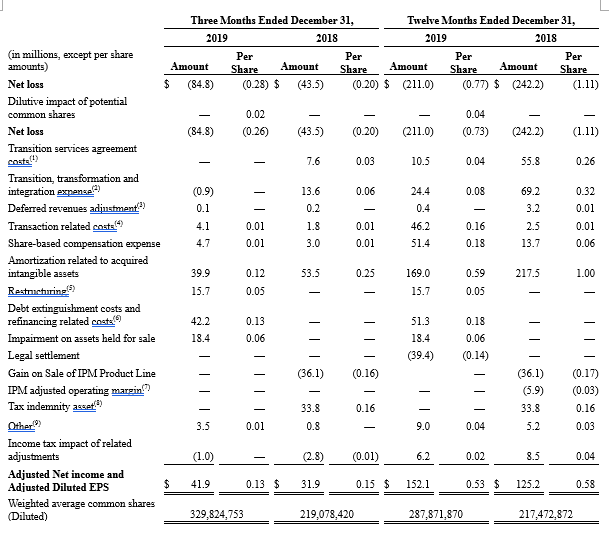
- Includes accruals for payments to Thomson Reuters under the transition services agreement. These costs have decreased substantially in 2019, as we are in the final stages of implementing our standalone company infrastructure.
- Includes costs incurred in connection with and after our separation from Thomson Reuters in 2016 relating to the implementation of our standalone company infrastructure and related cost-savings initiatives. These costs include mainly transition consulting, technology infrastructure, personnel and severance expenses relating to our standalone company infrastructure, which are recorded in Transition, integration, and other line-item of our income statement, as well as expenses related to the restructuring and transformation of our business following our separation from Thomson Reuters in 2016 mainly related to the integration of separate business units into one functional organization and enhancements in our technology.
- Reflects the deferred revenues fair value accounting adjustment arising from the purchase price allocation in connection with the 2016 Transaction.
- Includes consulting and accounting costs associated with acquisitions and the sale of the IPM Product Line and sale of MarkMonitor business
- Reflects costs incurred in connection with the initiative, following our merger with Churchill Capital Corp in 2019 , to streamline our operations by simplifying our organization and focusing on two product groups.
- Reflects costs incurred for the early extinguishment of debt and refinancing costs related to new debt. The twelve months ended December 31, 2019 includes a charge of $9.1 million recorded in the second quarter of 2019 relating to refinancing costs.
- Reflects the IPM Product Line’s operating margin, excluding amortization and depreciation, prior to its divestiture in October 2018.
- Reflects the write down of a tax indemnity asset.
- Includes primarily the net impact of foreign exchange gains and losses related to the re-measurement of balances and other items that do not reflect our ongoing operating performance.
Free Cash Flow
We use free cash flow in our operational and financial decision-making and believe free cash flow is useful to investors because similar measures are frequently used by securities analysts, investors, ratings agencies and other interested parties to evaluate our competitors and to measure the ability of companies to service their debt.
Our presentation of free cash flow should not be construed as a measure of liquidity or discretionary cash available to us to fund our cash needs, including investing in the growth of our business and meeting our obligations. You should compensate for these limitations by relying primarily on our U.S. GAAP results.
We define free cash flow as net cash provided by operating activities less capital expenditures. The following table reconciles our non-GAAP free cash flow measure to net cash provided by operating activities:

- Includes cash payments to Thomson Reuters under the Transition Services Agreement. These costs have decreased substantially in 2019, as we are in the final stages of implementing our standalone company infrastructure. In 2019, the Transition Services Agreement cash paid is offset by cash receipts from the IPM Product Line divestiture.
- Includes cash payments in connection with and after our separation from Thomson Reuters in 2016 relating to the implementation of our standalone company infrastructure and related cost-savings initiatives. These cash payments include mainly transition consulting, technology infrastructure, personnel and severance expenses relating to our standalone company infrastructure, which are recorded in Transition, integration, and other line-item of our income statement, as well as cash payments related to the restructuring and transformation of our business following our separation from Thomson Reuters in 2016 mainly related to the integration of separate business units into one functional organization and enhancements in our technology. This also includes cash payments following our merger with Churchill Capital Corp in 2019, to streamline our operations by simplifying our organization and focusing on two product groups.
- Includes consulting and accounting costs associated with acquisitions and the sale of the IPM Product Line and sale of MarkMonitor business.
Required Reported Data
Standalone Adjusted EBITDA
We are required to report Standalone Adjusted EBITDA pursuant to the reporting covenants contained in the Credit Agreement and the Indenture. Standalone Adjusted EBITDA is substantially similar to Consolidated EBITDA and EBITDA as such terms are defined under the Credit Agreement and the Indenture, respectively. In addition, the Credit Agreement and the Indenture contain certain restrictive covenants that govern debt incurrence and the making of restricted payments, among other matters. These restrictive covenants utilize Standalone Adjusted EBITDA as a primary component of the compliance metric governing our ability to undertake certain actions otherwise proscribed by such covenants. Standalone Adjusted EBITDA reflects further adjustments to Adjusted EBITDA for cost savings already implemented and excess standalone costs.
Because Standalone Adjusted EBITDA is required pursuant to the terms of the reporting covenants under the Credit Agreement and the Indenture and because this metric is relevant to lenders and noteholders, management considers Standalone Adjusted EBITDA to be relevant to the operation of its business. It is also utilized by management and the compensation committee of the Board as an input for determining incentive payments to employees.
Excess standalone costs are the difference between our actual standalone company infrastructure costs, and our estimated steady state standalone infrastructure costs. We make an adjustment for the difference because we have had to incur costs under the Transition Services Agreement after we had implemented the infrastructure to replace the services provided pursuant to the Transition Services Agreement, after we had implemented the infrastructure to replace the services provided pursuant to the Transition Services Agreement, thereby incurring dual running costs. Furthermore, there has been a ramp up period for establishing and optimizing the necessary standalone infrastructure. Since our separation from Thomson Reuters, we have had to transition quickly to replace services provided under the Transition Services Agreement, with optimization of the relevant standalone functions typically following thereafter. Cost savings reflect the annualized “run rate” expected cost savings, net of actual cost savings realized, related to restructuring and other cost savings initiatives undertaken during the relevant period.
Standalone Adjusted EBITDA is calculated under the Credit Agreement and the Indenture by using our Net Income for the trailing twelve month period (defined in the Credit Agreement and the Indenture as our GAAP net income adjusted for certain items specified in the Credit Agreement and the Indenture) adjusted for items including: taxes, interest expense, depreciation and amortization, non-cash charges, expenses related to capital markets transactions, acquisitions and dispositions, restructuring and business optimization charges and expenses, consulting and advisory fees, run-rate cost savings to be realized as a result of actions taken or to be taken in connection with an acquisition, disposition, restructuring or cost savings or similar initiatives, “run rate” expected cost savings, operating expense reductions, restructuring charges and expenses and synergies related to the transition following the separation of the Company’s business from Thomson Reuters (the “2016 Transaction”) projected by us, costs related to any management or equity stock plan, other adjustments that were presented in the offering memorandum used in connection with the issuance of the Notes and earnout obligations incurred in connection with an acquisition or investment.
The following table bridges Adjusted EBITDA to Standalone Adjusted EBITDA, as Adjusted EBITDA reflects all but three of the adjustments that comprise Standalone Adjusted EBITDA for the periods presented:
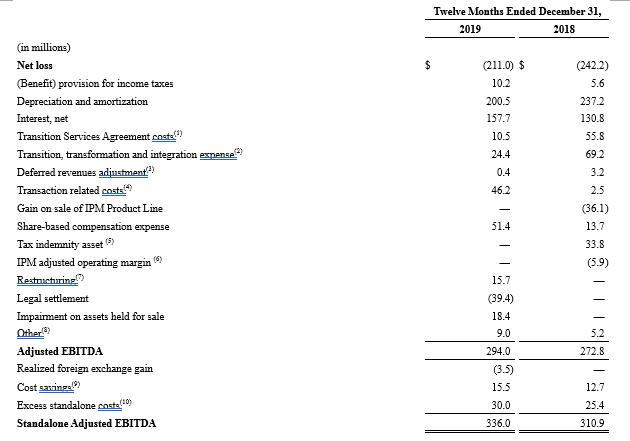
- Includes accruals for payments to Thomson Reuters under the Transition Services Agreement. These costs are expected to decrease substantially in 2019, as we are in the final stages of implementing our standalone company infrastructure.
- Includes costs incurred in connection with and after the 2016 Transaction relating to the implementation of our standalone company infrastructure and related cost-savings initiatives. These costs include mainly transition consulting, technology infrastructure, personnel and severance expenses relating to our standalone company infrastructure, which are recorded in Transition, integration, and other line-item of our income statement, as well as expenses related to the restructuring and transformation of our business following the 2016 Transaction, mainly related to the integration of separate business units into one functional organization and enhancements in our technology. Amounts incurred for the twelve months ended December 31, 2019 also relate to the Company’s transition expenses incurred following the Transactions.
- Reflects deferred revenues fair value accounting adjustment arising from purchase price allocation in connection with the 2016 Transaction.
- Includes consulting and accounting costs associated with the Transactions in 2019, the sale of the IPM Product Line and tuck-in acquisitions.
- Reflects the write down of a tax indemnity asset.
- Reflects the IPM Product Line’s operating margin, excluding amortization and depreciation, prior to its divestiture in October 2018.
- Reflects costs incurred in connection with the initiative, following our merger with Churchill Capital Corp in 2019, to streamline our operations by simplifying our organization and focusing on two product groups.
- Includes primarily the net impact of foreign exchange gains and losses related to the re-measurement of balances and other one-time adjustments.
- Reflects the estimated annualized run-rate cost savings, net of actual cost savings realized, related to restructuring and other cost savings initiatives undertaken during the period (exclusive of any cost reductions in our estimated standalone operating costs).
- Reflects the difference between our actual standalone company infrastructure costs, and our estimated steady state standalone operating costs, which were as follows:

The foregoing adjustments (9) and (10) are estimates and are not intended to represent pro forma adjustments presented within the guidance of Article 11 of Regulation S-X. Although we believe these estimates are reasonable, actual results may differ from these estimates, and any difference may be material. See “Cautionary Note Regarding Forward-Looking Statements” in the annual report.
The following tables present the amounts of our subscription and transactional revenues, including as a percentage of our total revenues, for the periods indicated, as well the drivers of the variances between periods.
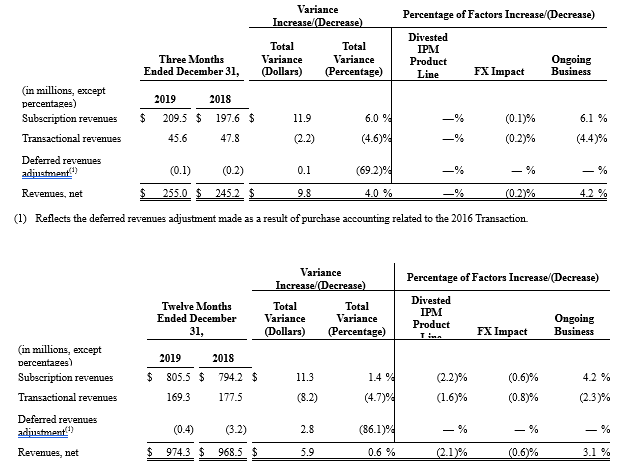
- Reflects the deferred revenues adjustment made as a result of purchase accounting related to the 2016 Transaction.
The tables below reflect the impact of the revenue generated by the IPM Product Line, including as a percentage of our total revenues, for the periods indicated, as well the drivers of the variances between periods. We sold the IPM Product Line in October 2018.
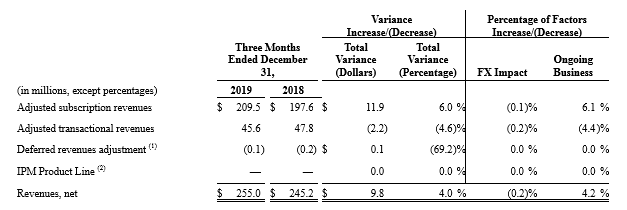
- Reflects the deferred revenues adjustment made as a result of purchase accounting related to the 2016 Transaction.
- Reflects the revenue generated by the IPM Product Line for the year ended December 31, 2018. We sold the IPM Product Line in October 2018.

- Reflects the deferred revenues adjustment made as a result of purchase accounting related to the 2016 Transaction.
- Reflects the revenue generated by the IPM Product Line for the year ended December 31, 2018. We sold the IPM Product Line in October 2018.
The following tables, and the discussion that follows, presents our revenues by Group for the periods indicated, as well the drivers of the variances between periods, including as a percentage of such revenues.

- Reflects the deferred revenues adjustment made as a result of purchase accounting related to the 2016 Transaction.
- Reflects the revenue generated by the IPM Product Line for the year ended December 31, 2018. We sold the IPM Product Line in October 2018.
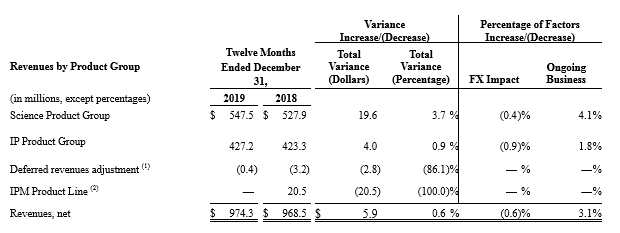
- Reflects the deferred revenues adjustment made as a result of purchase accounting related to the 2016 Transaction.
- Reflects the revenue generated by the IPM Product Line for the year ended December 31, 2018. We sold the IPM Product Line in October 2018.
The following table presents our calculation of Adjusted Revenues for the Outlook for 2020 and a reconciliation of this measure to our Revenues, net for the same period:

- The Company is evaluating the purchase accounting impact, including the deferred revenue adjustment, related to the DRG acquisition.
The following table presents our calculation of Adjusted EBITDA for the Outlook for 2020 and reconciles these measures to our Net loss for the same period:
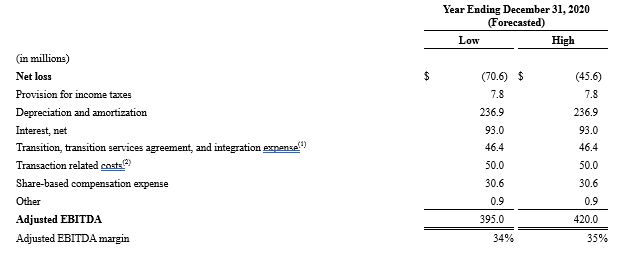
- Includes restructuring costs, other cost optimization activities, and payments and receipts under transition service agreements.
- Includes cost associated with merger and acquisition related activities.
The following table presents our calculation of Adjusted Diluted EPS for the Outlook for 2020 and reconciles these measures to our Net loss for the same period:
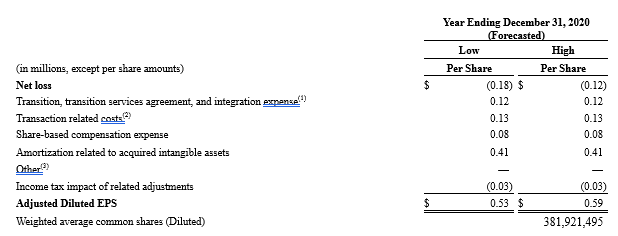
- Includes restructuring costs, other cost optimization activities, and payments and receipts under transition service agreements.
- Includes cost associated with merger and acquisition related activities.
The following table presents our calculation of Adjusted Free Cash Flow for the Outlook for 2020 and reconciles these measures to our Net loss for the same period:

- Includes cash payments related to restructuring and other cost optimization activities.
- Includes cash payments related to merger and acquisition related activities.
Media Contact:
Tabita Seagrave,
Head of External Communications
tabita.seagrave@clarivate.com
Investor Relations Contact:
Mark Donohue,
Head of Investor Relations
mark.donohue@clarivate.com





